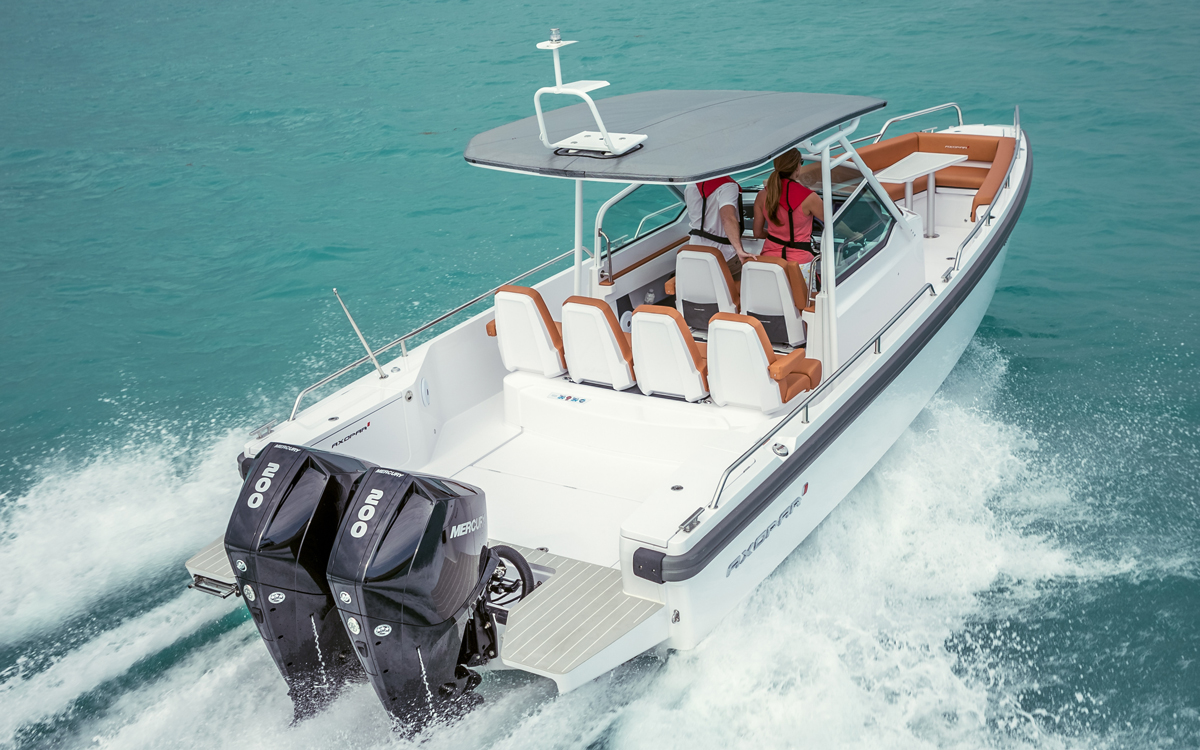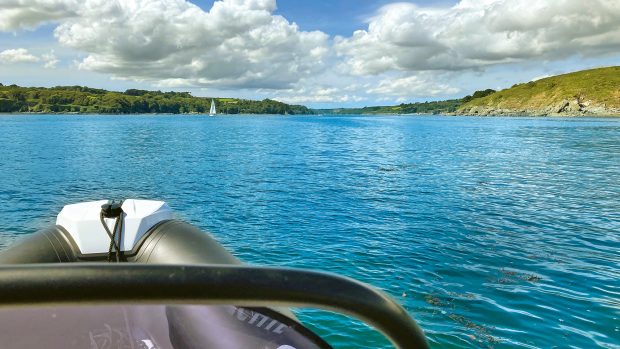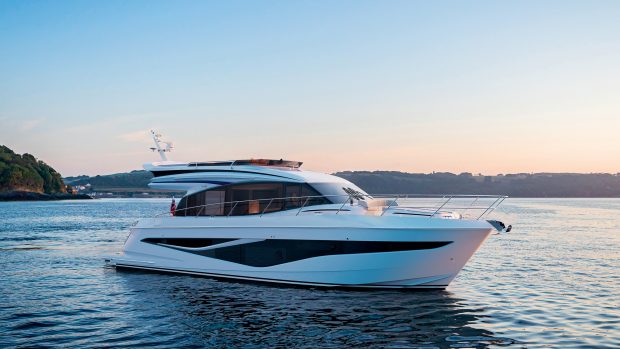Mercury goes large with a brand new range of 175-225hp 3.4-litre V6 outboards
The Mercury Verado range of supercharged 175-225hp outboard motors has been replaced by an all-new family of naturally aspirated 3.4-litre V6 outboards. The move marks a major change in direction for one of the world’s leading outboard engine manufacturers.
Until now, the company has relied on belt-driven superchargers to boost the power and torque of its mid-range engines, but it is now using additional cylinders and increased capacity to achieve the same power output with fewer drawbacks.
It claims the new engines are smoother, quieter, lighter, faster and more efficient than ever before, while a reduction in moving parts should make them easier to maintain and more robust.

A small cowling hatch opens to check and top up the oil level
The starting point for the new family of engines is an aluminium 3.4-litre V6 block with a 64° angle between the two banks of cylinders, creating just enough space for the powerful new alternator to sit between them.
This is claimed to be the best in class, with a maximum output of 85A at full revs and 20A at idle – crucial for keeping power-hungry navigation gear and stabiliser systems, such as the new Seakeeper 2, running when pottering along at slow speeds.
Size matters
By opting for a big-capacity V6 block (the old 200hp Verado uses a 1.7-litre 4), Mercury isn’t just abandoning its previous reliance on superchargers, it’s also going against the current trend towards high-power 4-cylinder engines.
Yamaha and Suzuki have both recently replaced their big 200hp V6 outboards with smaller, lighter 4-cylinder units. However, Mercury claims it has managed to achieve the same or better weight savings while hanging on to all the benefits of a V6 configuration.
Tipping the scales at just 215kg dry, the new 3.4-litre V6 outboard will be the lightest 200hp 4-stroke engine on the market, undercutting both the 4-cylinder Yamaha F200 (220kg) and the Suzuki DF200 (226kg). Even the 200hp version of Evinrude’s latest G2 2-stroke engine is heavier at 240kg.
Article continues below…

Yamaha 425hp outboard: Most powerful V8 set-up tested

Diesel outboard head-to-head test: Cox CXO 300hp vs Oxe 200hp
Mercury says every element of the new engine was subjected to a rigorous weight-saving routine, with composite intake runners and heavier items like the flywheel and camshaft sprockets being cast and machined to remove unnecessary bulk.
Crucially, V6 outboards are naturally better balanced than in-line fours, an advantage that Mercury is seeking to capitalise on with additional features designed to reduce unwanted noise and vibrations even further.
Multi-chamber air intakes dissipate induction roar, while fuel injector covers dampen high-frequency noise; a new cowling design with extra sound insulation and a simple one-touch locking system help to prevent any remaining mechanical noises from escaping.
The cowling itself features an aggressive new angular design and comes in a variety of colours. Phantom Black is still the default option, but three different shades of white (Pearl, Warm and Cold) and four colour accents (red, blue, silver and grey) allow owners to personalise the looks of their engines.

Buyers have different cowling colours and four different accent stripes to choose from to personalise their engine and try to match their boat
Fighting torque
Although Mercury has not released torque figures for the new V6 outboards (usually a strong point of forced induction engines like the previous Verado), it claims the 200hp V6 has 20% more torque between 3,500 and 4,500rpm than its nearest naturally aspirated 4-cylinder competitor, resulting in 18% faster acceleration from 0-20mph on its own 23ft test boat.
Fuel efficiency is also improved, partly because superchargers are notoriously thirsty, sapping up to 15% of the power to drive the scrolls, and partly because of a new Advanced Range Optimization (ARO) electronic management system and a closed-loop fuel system that constantly monitor and adjust the fuel/air mix to promote lean-burn running. Mercury claims 12-16% better fuel economy than the leading competitor.

The big capacity naturally aspirated 3.4-litre V6 develops up to 225hp
Other clever features include a small pop-up panel on top of the cowling, like the fuel filler flap on a car, that allows you to check the oil level and top it up without removing the main engine cover.
There’s also a form of electronic cruise control called Adaptive Speed Control that maintains the engine’s RPM regardless of load or conditions.
This comes into its own during hard cornering or heavy seas where the engine would normally slow down or surge, but will now maintain a constant speed.
All the new engines are designed to work with either mechanical or digital throttle controls and hydraulic or power steering to maximise retrofitting options.
We’ll have to wait for a full sea trial of the new V6 outboards to see if these claims hold water. Also, the pricing, servicing schedules and warranty backups have yet to be confirmed for the UK.
However, the firm’s reputation for building powerful and reliable outboard motors combined with its strong relationship with boatbuilders like Boston Whaler, Axopar and XO, as well as Brunswick brands such as Sea Ray and Bayliner, is likely to ensure strong demand for the new V6 outboards.
Verado lives on
Although these naturally aspirated engines mark a change in Mercury’s development strategy, supercharging will still live on in the more powerful 300-400hp Verados. It’s hard to see how it could deliver this power-to-weight ratio without some form of forced induction. Its 350hp rivals from Yamaha and Suzuki are significantly heavier and still can’t match the 400hp output of the Mercury 400R.
Most high-performance cars now use smaller turbo-charged engines to match the demand for more power with the increasingly stringent rules on fuel consumption and emissions. Perhaps this is the route Mercury will have to take for any future engines of 300hp or more.
Comparison table of 200hp outboard engines
| Mercury | Mercury | Yahama | Suzuki | Honda | Evinrude |
|---|---|---|---|---|---|
| V6 200 | Verado 200 | F200 | DF200 | BF200 | G2 |
| 3.4 litre | 1.7 litre | 2.8 litre | 2.9 litre | 3.5 litre | 2.7 litre |
| V6 | 4 | 4 | 4 | V6 | V6 |
| 215kg | 231kg | 220kg | 226kg | 267kg | 240kg |
| 85A | 70A | 50A | 44A | 60A | 50A |










